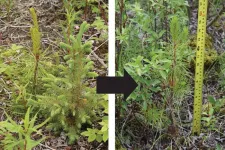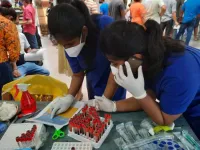(Press-News.org) Shared micromobility (including shared electric scooters and bikes provided by private companies) is one of the newest transportation options that has come to cities in the last several decades. A new report explores the different ways cities charge shared micromobility companies to operate, and how these funds are used.
In the newly released report, John MacArthur of Portland State University, Kevin Fang of Sonoma State University and Calvin Thigpen of Lime examine data from 120 cities in 16 countries around the world. They also conducted a survey of cities’ shared micromobility program managers, with responses representing 33 jurisdictions in North America.
Download the report: "Taxing shared micromobility: assessing the global landscape of fees and taxes and their implications for cities, riders, and operators (PDF)"
"This study builds our understanding of a topic that is near and dear to the hearts of cities, riders, and micromobility operators: how to run a system that is affordable for riders while also remaining financially sustainable for micromobility operators. In the last 6 months alone, the industry has seen substantial upheaval through mergers, bankruptcies, and closures. So as cities revisit their program regulations, we hope they take into consideration that the industry has matured substantially since fees were initially established - with safer vehicles, better operations, and closer city collaboration - as well as the role shared micromobility can play in achieving sustainability and equity goals," Thigpen said
Digging into how each city made the decision of what to charge, the researchers find that taxes and fees vary dramatically from city to city and may not always reflect the city's stated policy goals.
"Though cities are using fees and taxes to mitigate the cost of program administration, which is very understandable given local budget constraints, these additional costs to riders can be at odds with a city’s broader goals for supporting sustainable and equitable transportation," MacArthur said.
The findings also reveal a trend of cities charging less for shared bicycles than for shared scooters. The notable exception to this pattern is Denver (which has both e-bikes and scooters), where the city does not differentiate between vehicle types and charges no program fees.
"One concern sometimes raised about shared micromobility are user fares. To the degree fees increase the cost of business and get passed along to riders, cities have a say in fares with their fee levels," Fang said.
Four Key Findings
1) Fees vary dramatically between cities. Some cities do not impose program fees at all, in line with municipal transportation goals. In cities that do assess program fees, the common types are per-trip, per-vehicle, flat annual, and flat one-time fees. There are large differences in the fee amounts that cities charge – for example, the highest per-vehicle fee is over four hundred times higher than the lowest.
"Fee levels were consistently inconsistent. In some cases, cities had zero permit fees. On the other end they could be a dollar or two for every trip," Fang said.
2) Shared micromobility is taxed twice—via sales tax and program fees—and these revenues can be substantial. On average, cities charging an annual fee received over a third of a million USD each year. If sales taxes/value added taxes (VAT) are included with fees, the average shared micromobility trip generates a fee + tax revenue of $0.70 USD per mile or $0.89 USD per trip. This means that globally, shared micromobility programs bring in an average rate of 16.4% of revenue from user fares in taxes and fees.
3) Shared micromobility taxes and fees are higher than most other modes of transportation, especially driving and ridehail. The research team found that fees and taxes on shared micromobility are significantly higher compared to other travel modes, being 23 times higher per mile than personal cars and over 5 times higher than ridehail trips.
"On average, fees and taxes on shared micromobility were quite a bit higher than charges on personal driving or ride-hail trips. This seems counter to many cities' goals of promoting alternative modes of travel," Fang said.
4) When deciding on fees, cities are especially concerned with covering administrative costs as well as influencing operator behaviors. The primary use of fee revenue is to cover program administration costs, rated as the top consideration by 77% of respondents (see chart below). Ensuring financial feasibility for scooter companies or lowering rider costs were less prioritized, even though both would benefit the shared micromobility system.
While cities’ concerns over budget are understandable, this consideration can be at odds with cities’ broader goals for supporting alternative transportation.
"After the boom of shared micromobility in 2017, cities looked at fees as a way to react to this new mode. We see that cities are still setting fees to cover program administration costs, but also as a way to influence operator behavior of how they operate their systems in the public rights-of-way," MacArthur said.
Download the report (PDF) for details about the research, including the survey that was distributed to shared micromobility program staff and the methods used to calculate taxes and fees for other modes of transportation. The report's appendix includes a complete summary of program fees in each jurisdiction as well as shared micromobility program fee revenues in 2022.
Who Can Use This Research?
Fees and taxes are relevant to all three of the major "stakeholders" in the shared micromobility field: cities, private micromobility companies, and travelers.
There have been numerous studies on cities’ shared micromobility policies around parking, ridership, safety, equitable distribution of vehicles, and sustainability. By contrast, there has been little research on the taxes and fees levied on shared micromobility systems and how they work to advance or deter municipal goals for shared micromobility.
The researchers provide case studies of cities taking different—and evolving—approaches to illustrate how different cities weigh tradeoffs. The information provided in this report can help inform cities who are working with shared micromobility companies to align program fee structures with their goals around climate, equity, congestion and more.
In a section offering rationales for lowering (or not charging) fees, the report notes that the shared micromobility landscape has changed since e-scooters first swept the world in 2017 and 2018. The shared micromobility industry no longer deploys at-will in city streets, but rather works through formal procurement processes to serve cities.
"Considering the newness of shared micromobility, it is not that surprising that approaches to fees have varied so widely initially. Today, though, cities are mostly on the same page with what they want with micromobility operations, so greater alignment on fees probably makes sense," Fang said.
Shared scooters and bikes are no longer just pilots; most cities now have multi-year permits with established operators. Both cities and companies are aware of the risks of poorly managed systems and have developed technologies and programs to address equity and operational challenges. This research offers a comprehensive look at how cities around the world are approaching the question of what to charge, and offers strategies to ensure that a city's fee structure supports transportation policy goals.
Portland State University's Transportation Research and Education Center (TREC) is home to the U.S. DOT funded National Institute for Transportation and Communities (NITC), the Initiative for Bicycle and Pedestrian Innovation (IBPI), PORTAL, BikePed Portal and other transportation grants and programs. We produce impactful research and tools for transportation decision makers, expand the diversity and capacity of the workforce, and engage students and professionals through education and participation in research. To get updates about what's going on at TREC, sign up for our monthly newsletter or follow us at the links below.
Facebook | Instagram | LinkedIn | TikTok | Threads | X | YouTube
END
Taxing shared micromobility: How cities are responding to emerging modes, and what's next
2024-06-27
ELSE PRESS RELEASES FROM THIS DATE:
June research news from the Ecological Society of America
2024-06-27
The Ecological Society of America (ESA) presents a roundup of four research articles recently published across its six esteemed journals. Widely recognized for fostering innovation and advancing ecological knowledge, ESA’s journals consistently feature illuminating and impactful studies. This compilation of papers explores the potential for pines to establish in pine-free interior Alaska, internet sleuthing to assess birds’ extinction risk and more, showcasing the Society’s commitment to promoting cutting-edge research that furthers our understanding ...
Antibody-drug conjugate highly effective in preventing recurrence in patients with early stage HER2+ breast cancer, trial finds
2024-06-27
A year of treatment with a medicine made of an antibody and chemotherapy drug has proven highly effective in preventing stage 1 HER2-positive breast cancer from recurring in patients, a team led by Dana-Farber Cancer Institute researchers has found.
In a clinical trial involving 512 patients with the earliest stage of breast cancer that tested positive for the HER2 protein, 97% of those treated with trastuzumab emtansine (T-DM1) after surgery were alive and free of invasive cancer five years after treatment. The results, published online today in the Journal of Clinical Oncology, suggest that T-DM1 is a reasonable treatment approach for this stage 1 population, the study authors ...
Ephemeral streams, often overlooked, are major contributors to US river flow and water quality
2024-06-27
Ephemeral streams – temporary streams that only flow after rainfall or snowmelt – contribute more than 50% of the flow in downstream river systems and likely have a major influence on water quality across the United States, according to a new modeling study. The findings show how important ephemeral streams are for the transport of water and pollution into larger, more permanent water bodies. Excluding these streams from coverage under the U.S. Clean Water Act, say the authors, would significantly limit federal authority to protect downstream water quality. Ephemeral streams, which flow only in direct response to precipitation and are disconnected from groundwater sources, ...
From a Pompeii-like ash burial in Morrocco: Pristine 3D anatomy of Cambrian trilobites
2024-06-27
Thanks to being rapidly entombed in volcanic ash – in a “Pompeii-like” process – Cambrian-age trilobites’ anatomy is more discernable than ever, via exquisitely preserved fossils. The fossils uncovered in Morrocco are reported in a new study that reveals microscopic details including of trilobite appendages and the trilobite digestive system. Trilobites are perhaps the most well-known creatures that lived during the Cambrian Period. These extinct marine arthropods’ hard exoskeleton lends itself to high fossilization potential, facilitating the identification of more ...
Novel epigenic editor, CHARM, enables brain-wide prion protein silencing
2024-06-27
In a new study in mice, researchers introduce “CHARM,” a compact and versatile epigenetic editor that can be used to silence prion protein throughout the brain. The tool provides a path towards an effective first-line treatment for patients with deadly prion disease as well as other neurodegenerative diseases caused by the toxic buildup of unwanted proteins. Prion disease – a suite of devastating neurodegenerative disorders that result in rapid-onset dementia and death – is caused by misfolding of the prion protein, PrP, to form toxic aggregates that result in neuronal death. Previous research in mice has shown that removing PrP ...
A promising weapon against measles
2024-06-27
LA JOLLA, CA—What happens when measles virus meets a human cell? The viral machinery unfolds in just the right way to reveal key pieces that let it fuse itself into the host cell membrane.
Once the fusion process is complete, the host cell is a goner. It belongs to the virus now.
Scientists in the La Jolla Institute for Immunology (LJI) Center for Vaccine Innovation are working to develop new measles vaccines and therapeutics that stop this fusion process. The researchers recently harnessed an imaging technique called cryo-electron microscopy to show—in ...
The most obese children with dengue are more than twice as likely as others to be hospitalized with dengue, according to study of 4,782 10- to 18-year-olds in Sri Lanka
2024-06-27
The most obese children with dengue are more than twice as likely as others to be hospitalized with dengue, according to study of 4,782 10- to 18-year-olds in Sri Lanka.
####
Article URL: http://journals.plos.org/plosntds/article?id=10.1371/journal.pntd.0012248
Article Title: Is the rise in childhood obesity rates leading to an increase in hospitalizations due to dengue?
Author Countries: Sri Lanka, United Kingdom
Funding: This study has been supported by the World Health Organization Unity Studies (GNM and CJ), a global sero-epidemiological standardization initiative, with funding to the World Health Organization and the UK Medical Research Council (GSO). The World Health Organization ...
Prehistoric Pompeii discovered: Most pristine trilobite fossils ever found shake up scientific understanding of the long extinct group
2024-06-27
Researchers have described some of the best-preserved three-dimensional trilobite fossils ever discovered. The fossils, which are more than 500 million years old, were collected in the High Atlas of Morocco and are being referred to by scientists as “Pompeii” trilobites due to their remarkable preservation in ash.
The trilobites, from the Cambrian period, have been the subject of research by an international team of scientists, led by Prof Abderrazak El Albani, a geologist based at University of Poitiers and originally from Morocco. The team included Dr Greg Edgecombe, a palaeontologist ...
Scientists use computational modeling to guide a difficult chemical synthesis
2024-06-27
CAMBRIDGE, MA — Researchers from MIT and the University of Michigan have discovered a new way to drive chemical reactions that could generate a wide variety of compounds with desirable pharmaceutical properties.
These compounds, known as azetidines, are characterized by four-membered rings that include nitrogen. Azetidines have traditionally been much more difficult to synthesize than five-membered nitrogen-containing rings, which are found in many FDA-approved drugs.
The reaction that the researchers used to create azetidines is driven by a photocatalyst that excites the molecules from their ground energy state. Using computational models that they developed, the researchers ...
The worm has turned: DIY lab platform evaluates new molecules in minutes
2024-06-27
Plants are powerhouses of molecular manufacturing. Over the eons, they have evolved to produce a plethora of small molecules — some are beneficial and valuable to humans, others can be deadly. For years, a good way for scientists looking for new medicines to distinguish beneficial plant-derived molecules from harmful ones has been through a scientific sniff test — dab a bit of the molecule at one end of a petri dish and drop tiny nematode worms (C. elegans) at the other, then wait to see if the chemically sensitive worms move toward or away from the compound in question, a process known as chemotaxis.
This “artisanal” ...



